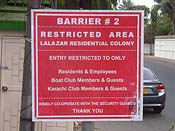Towards an Urban Geopolitical Analysis of Violence in Lyari
July 15, 2013 Leave a comment
A recent article I wrote for the Center for Research and Security Studies. See link: Towards an Urban Geopolitical Analysis of Violence in Lyari
The Lyari district of Karachi has been in the headlines for quite some time. Politically protected criminals reportedly operate out of this centrally located district. Considered one of the most volatile districts in violence-hit Karachi in southern Pakistan, Lyari has recently witnessed pitched battles between members of alleged criminal syndicates and paramilitary forces. CRSS visiting research fellow herewith provides a brief insight into the embattled Lyari.
If Lyari is nostalgically remembered as a microism of Pakistan (Bhutto, 2010) then perhaps the problem of recurring violence in Lyari is also a microism of Pakistan’s problems. Every now and again, Lyari becomes a hotbed of violence. Images of residents battling with government security forces, using sophisticated weapons shock the nation. Countless TV shows, news articles, and analysts try to make sense of what is going on. They all come to the same conclusion: The criminal/ethno-political/mafia nexus has gained incredible strength in Lyari, and the situation is beyond ordinary law and order forces. How can these groups be disbanded if security forces can’t enter the ‘enclave’? How can these groups be overpowered if they are better armed than the police? And how can they be negotiated with if they are aware of their status as lucrative militant wings for political advantage? These questions beg to be answered through a geopolitical analysis of this conflict. Looking deeper towards the political geography of Lyari is necessary to understand that this ‘new’ form of military urbanism is a thing of our own making.
A multi-ethnic enclave, divided into distinct pockets, Lyari is an ordinary low income settlement situated strategically between the Lyari Expressway and Mauripur Road. Within Lyari, there are complex rules of accessibility- where you can go depends on who you are. The different neighbourhoods are infiltrated by ‘gangs’, and for many outsiders (including police and security forces), they remain ‘no-go areas’. Lyari’s no go areas are largely an outcome of socio-political reasons. A neighbourhood that lies on the margins of urban society finds itself resolving infrastructural and municipal problems through resident power brokers who promise a more local and accessible government (Kaker, forthcoming). At the same time, urban disenfranchised youth get attracted to the pull of power and wealth associated with criminal and mafia activities (Verkaik, 2004). Despite local efforts at keeping youths off the street (see Lyari Resource Center), violence emits an allure that calls to an otherwise excluded group of people to heights of glory.
Adding complexity to this situation, the dirty politics played by police and political parties in the last two decades has only exacerbated the issue (Khan, 2012). In attempting to control criminal elements, the police has time and again made strategic alliances with different gangs, only to escalate violence within the area. Similarly, the PPP notoriously co-opted Rehman Dakait’s gang by stoking his political ambition against the promise of a constituency in a city dominated by MQM, and also with the idea of having a militant wing to counter that of the MQM’s. This patronage by police forces and political parties reflects the political culture of the country itself: It mirrors the Pakistan army and the civilian government’s strategy of co-opting political and military advantage through tactics such as plausible deniability in its military adventures beyond the borders. The consequences of these adventures are similar: the gangs of Lyari understand their strategic significance, and yet aspire towards more power. Remaining untamed, they keep their own interests at heart, and remain in the game as long as it favours them.
The gangs of Lyari now play to a different tune. Their alliances with Taliban elements prove to strengthen their political power. Known to expand their existing criminal activities towards kidnapping people to sell to the Taliban, and to buy heavy caches of weapons stolen from NATO supplies with the help of the Taliban (Hussain, 2013), the gangs of Lyari’s alliance with the Taliban have added to their clout. Political parties such as the MQM and the PPP hoping to coopt them within their sphere of influence now have to do so on the terms set by the criminals. Similarly, police operations can only go so far in rooting them out, as these gangs are much stronger than they were in the last decade. Only a concentrated effort that combines political isolation and military action can weed them out. Yet, this is merely wishful thinking. Karachi’s vote politics is at the heart of the problem, and it will stoke it for longer still.
References:
Budhani, A.A., Gazdar, H., Kaker, S.A. and Mallah, H.B. (2010) ‘The Open City: social networks and violence in Karachi’, Working Paper No:70 (series 2), [Online]. Available at: http://www.crisisstates.com/download/wp/wpSeries2/WP70.2.pdf (Accessed: 29 October 2010).
Hussain, T. (2013) ‘Karachi is part of Pakistani Taliban plan to bring war to urban centers’, McClatchy Newspapers, http://www.mcclatchydc.com/2013/04/29/189908/karachi-is-part-of-pakistani-taliban.html#.Ud6-5W1QNj0 [Online] (Accessed: July 10, 2013).
Kaker, S.A. (Forthcoming, 2013) ‘The Geopolitics of Enclaved Urbanism: a case study of Karachi’, South Asian History and Culture, p. 17.
Khan, F. (202) ‘Violence 101: A primer to the Lyari Gang War’,http://tribune.com.pk/story/372834/violence-101-a-primer-to-the-lyari-gang-war-karachi/[Online] (Accessed: July 10, 2013).
Verkaaik, O. (2004) Migrants and militants: fun and urban violence in Pakistan. Princeton and Oxford: Princeton University Press.
![[image]](https://i0.wp.com/si.wsj.net/public/resources/images/WO-AN206_KARACH_G_20130328184400.jpg)




